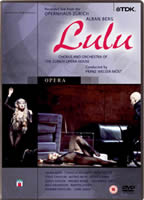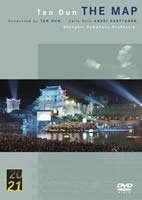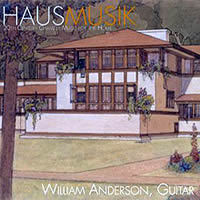Fresh and Canned
|
Grant Chu Covell [January 2006.] Wozzeck may be this season’s biggest surprise at The Metropolitan Opera. Not surprisingly, the orchestra shone under James Levine, a leading Berg interpreter. Winds and onstage musicians expertly navigated their intricate parts. It thrilled to hear the famed single-pitch crescendo punch through the theatre. What tripped this production across the line into greatness was the cast’s consistently strong singing and acting. Alan Held portrayed the complex, weary eponym. Less poetic than Fischer-Dieskau’s classic interpretation (now on DG 435705), his lumbering manner conveyed a feral force in the grip of indecision. A brilliant application of light and shadow emphasized the difference between Held’s looming Wozzeck and Graham Clark’s diminutive, hypochondriacal Captain. Walter Fink’s megalomaniac Doctor — the quack compliments the superstitious Captain — took to his role eagerly. Clark and Fink were no bit players. At the end, when the duo wanders past the drowning Wozzeck, you’d think they were about to launch into their own sequel. Katarina Dalayman’s Marie — the only extended female role — was down-to-earth. Doubts and ultimately her murder shattered her yearning for calm oases. Perhaps the toughest role is that of the child. Non-speaking until the last scene, where the other children taunt him and then run off to gawk at his mother’s dead body, he must skip nimbly on his hobbyhorse and align his “Hopp, hopp!” with a xylophone. Berg meticulously specifies myriad effects, from curtain falls to the rhythm of laughter. The production takes reasonable liberties. After the strutting Drum Major (Clifton Forbis) first appears, Marie should slam shut a window. Berg’s music instantly shifts from offstage band to orchestra pit in order to emphasize the change. On the New York stage, absent a window, Marie slapped a wall. Eighty years after its premiere, Wozzeck still hasn’t achieved the mainstream. While most of the audience erupted into enthusiastic appreciation after the opera’s 100 minutes, others fidgeted throughout. The night I attended (12-27-05), several audience members opened their programs, saw what was about to take place, and fled!
I hope Levine will bring Lulu into the Met’s repertoire. Whether it’s the unfinished two-act version or Cerha’s three-act assemblage doesn’t matter. Like any opera, Lulu relies on a strong cast and its director’s vision. (Name another opera which contains a movie.) Director Sven-Eric Bechtolf applies a stark back-story to the incomplete version (TDK DVUS-OPLULU): The ersatz heroine becomes a child-abuse victim who manipulates everyone within her sphere. The production’s nudity and violence parallel the story of a “saved” prostitute who triggers her lovers’ deaths only to succumb to tuberculosis and perish, finally, under Jack the Ripper’s knife. They didn’t teach soprano Laura Aikin to wear a fishnet body stocking in Lieder school. Instead of the artist’s painting, there’s an explicitly detailed multi-part mannequin carried in clear plastic boxes. Recorded at the Opernhaus Zürich, Franz Welser-Möst conducted the chorus and orchestra of the Zurich Opera. Definitely not a production for American eyes. * * * A spare ticket permitted me to hear the Boston Symphony Orchestra in Tan Dun’s Water Concerto and Bruckner’s mighty Seventh (1-5-06). Christopher Lamb, flanked by two orchestral percussionists, was the able percussion soloist in the Tan Dun. All three dropped and manipulated various objects in large, water-filled bowls. Kurt Mazur conducted all most elegantly, including lighting and amplification. Upon reaching the podium to the audience’s acclaim, the house lights dimmed and the percussionists commenced twittering on saw-like gadgets as light slowly filled the stage. Every composition student has dipped a reverberating gong into water and enjoyed the glissando effect. Using the sound intelligently is an entirely different matter. Tan Dun’s arsenal included this and other clever manipulations of sound Stockhausen and Schaeffer first exploited back in the day. You could argue that without a live soloist, the plops and drips could have been better achieved electronically. (I craved Tudor’s electronic grit.) But then, there’d have been nothing to watch: For no reason I could discern, the soloist futzes his way to the back of the stage where he doodles on a vibraphone, clacking his mallets on his return. For all the novel effects, including slapping brass mouthpieces with the flat of the hand, Tan Dun’s composite strikes me as misguided. Maybe a fondness for Lachenmann has dulled my ears to Tan Dun’s toy shop with its bluntly derivative orchestral writing, minimalist pentatonicism, coy glissandi and ensemble foot-stomping. Ironically, Tan Dun dedicated Water Concerto to Takemitsu, who did better at bridging East and West. In attempting to celebrate his Chinese heritage, all Tan Dun serves up is tepid chop suey. The Boston audience swallowed it whole, in part because it was tame and chintzy (to everyone’s detriment, it probably reminded them of pagoda-decked restaurants), yet Mazur’s clear devotion to the opus had us all spellbound. After the break, we were treated to Bruckner’s imposing cathedrals. Who wouldn’t enjoy hearing bold brass augmented by four Wagner tubas? The BSO delivered the goods. However, I could also see why some dislike Bruckner, as the Seventh is lengthy and of nominal means. For the record, I heard two cell phones and a couple of wristwatches chime the hour.
For better Tan Dun experiences, try a pair of DVDs: the hit movie Crouching Tiger, Hidden Dragon, for which Tan Dun wrote the score, and The Map (DG 073 401). Like Herzog’s Fitzcarraldo, Tan Dun brought his concerto for cello, orchestra and video, originally premiered by Yo-Yo Ma and the BSO, to specially built stages in rural China (a boatload of administrators, translators, the Shanghai Symphony and a dedicated documentary crew followed him). For this “musical anthropology,” Tan Dun used a handheld video camera to capture documentary footage of the Tuja, Miao and Dong cultures, scoring a cello concerto over the filmed images and performers. Here too the composer’s material is marginally less inspired than his sources, though the cello’s vocalizations (Anssi Karttunen) offer more expressive possibilities than water-based percussion. * * * Live music is addictive. After the Tan Dun / Bruckner Thursday, I sought out another BSO concert featuring a freshly commissioned work from Jonathan Dawe alongside Schumann and Berlioz (1-14-06). Dawe was a few years ahead of me in undergraduate music school. His works had a gravitas which most of my peers would never attain, thus my incentive to attend his BSO premiere. Coincidentally, I last attended the BSO under Levine’s direction exactly a year earlier for a fervently anticipated concert of Sibelius and Babbitt (1-14-05). Babbitt’s 2004 Concerti for Orchestra was hard work for orchestra and audience. The hall response was cool, growing passably enthusiastic when Levine trotted out the 88-year-old composer for two bows. I was disheartened to overhear audience grumblings: “I don’t know how much of this I can take,” and on the way out a proud voice: “I’m still recovering from the Babbitt.” Concerti was sandwiched between Sibelius’ Fourth and Fifth. Either epic programmed singly approaches nirvana — together they range from despondency to ecstasy — yet I sensed the BSO was withholding slightly, perhaps a petulant reaction to negotiating the gnarly Babbitt. Dawe’s work with Babbitt at Juilliard strengthened his familiarity with serialism and 12-tone procedures. He also admits to a love for earlier music, having played crumhorn at Oberlin. His present style couples epochs. Baroque gestures are manipulated via theories derived from fractal geometry, “[r]otational arrays, Stravinsky verticals, spectral trees, and cellular automata.” The title comes directly from Marc-Antoine Charpentier’s Les Arts Florissants, from which Dawe borrows characters, here in modern dress. After the initial surprise of Baroque progressions overwhelmed by Xenakian pratfalls, I rather enjoyed the piece. The polystylistics succeed — shades of Ives’ or Zimmermann’s best. Most impressive is how Dawe, like late Strauss, maintains transparency of texture.
A few years back, Furious Artisans’ “Hausmusik” (FACD 6802) came my way. The disc features Dawe’s neat little Under the Tafelmusik on William Anderson’s eclectic program of guitar works by Hindemith, Babbitt, Hans Erich Apostel, Ernst Krenek and others. Furious Artisans (http://www.furiousartisans.com/) announces a March release devoted to Dawe’s chamber music. As surrounding Babbitt with two meaty Sibelius symphonies shows, Levine’s programming is earnest and aggressive. After the Dawe we heard Schumann’s Fourth and Berlioz’s Symphonie fantastique, either a satisfactory concert closer, but together a knockout pair. (Last year Levine sequenced Dutilleux’s Second, Stravinsky’s Symphony of Psalms, Carter’s Boston Concerto and Bartók’s Concerto for Orchestra. In March, Schoenberg’s Chamber Symphony No. 1 precedes Beethoven’s Ninth.) Levine brought clarity to Schumann’s structure, emphasizing interconnected themes. Berlioz’s opium dream was luscious. Watching the BSO at work elucidates the orchestration: Brass, bassoons, E-flat clarinet and English horn were reserved, with four percussionists playing two sets of timpani. It amused to watch one player juggling tuba and bass tuba. Keeping track of interruptions, I heard only one cell-phone ring that Saturday night. A few grumble that Levine’s programming exhausts ticket holders and players, yet a heartening statistic reveals more single-ticket sales. Of equal interest, according to Richard Dyer in The Boston Globe, 12-25-05, “… single tickets are being sold to an important part of the public that stayed away during the later Ozawa years: students, young people, members of the academic community, and the community of professional musicians (composers, performers, musicologists, and teachers)” — in other words, to folks like me who care passionately about particular chunks of repertoire. Levine and the BSO grow more compatible each year. If Levine maintains strong programming, next season the hall ought to be filled with genuinely interested audiences.
[More Grant Chu Covell]
[Previous Article:
Mostly Symphonies 2.]
[Next Article:
In Iceland]
|


